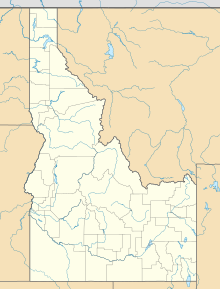 Bunker Hill smelter in operation during the 1970s | |
| Location | |
|---|---|
| Location | Silver Valley (Idaho) |
| State | Idaho |
| Country | United States |
| Coordinates | 47°32′28″N 116°08′53″W / 47.541111°N 116.148056°W |
| Production | |
| Products | Silver, Lead, Zinc, Gold, Copper, Cadmium, Antimony, Cobalt, Uranium[1] |
| Type | Underground |
| History | |
| Discovered | 1885 |
| Opened | 1886 |
| Active | 1886-1889, 1891-1981,1988-1991 |
| Closed | 1991 |
| Owner | |
| Company | Bunker Hill Mining Corporation |
| Website | bunkerhillmining |
The Bunker Hill Mine and Smelting Complex (colloquially the Bunker Hill smelter) was a large smelter located in Kellogg, Idaho, in the Coeur d'Alene Basin. When built, it was the largest smelting facility in the world.[2] It is located in what became known as the Silver Valley of the Coeur d'Alene Basin, an area for a century that was a center of extensive silver and other metal mining and processing. This resulted in extensive contamination of water, land and air, endangering residents including the Coeur d'Alene Tribe, which had traditionally depended on fish from the waterways as part of its subsistence.
In 1983 the United States Environmental Protection Agency added this area to the National Priorities List as a Superfund site for investigation and cleanup. In 1991 the Coeur d'Alene Tribe filed suit against the mining companies for damages and cleanup costs; they were joined by the federal government in 1996 and the state of Idaho in 2011. Settlement was reached with the two major defendants in 2008 and 2011, with an agreement for funding of $263.4 million plus interest for cleanup and restoration of habitat.
- ^ "Bunker Hill Mine". Mineral Resource Data System. United States Geological Survey. Retrieved April 23, 2020.
- ^ National Research Council, 2005: 16
